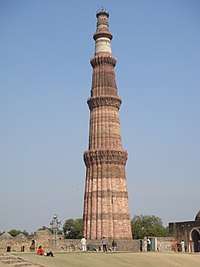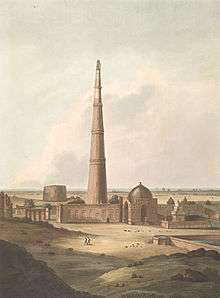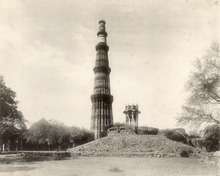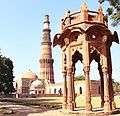Qutb Minar
| Qutub Minar | |
|---|---|
 Qutub Minar in Delhi, India | |
| Coordinates | Coordinates: 28°31′28″N 77°11′07″E / 28.524355°N 77.185248°E |
| Height | 73 metres (240 ft) |
| Type | Cultural |
| Criteria | 4 |
| Designated | 1993 (17th session) |
| Reference no. | 233 |
| Country |
|
| Continent | Asia |
| Construction | Started by Qutub-ud-din Aibak / completed by his son-in-law Iltutmish |
 Location of Qutub Minar in India | |
The Qutub Minar, also spelled as Qutab Minar, or Qutb Minar, is the tallest minaret in the world made up of bricks. The minaret forms a part of the Qutab complex, a UNESCO World Heritage Site in the Mehrauli area of Delhi, India.[1][2] Qutub Minar is a 73-metre (239.5 feet) tall tapering tower of five storeys, with a 14.3 metres (47 feet) base diameter, reducing to 2.7 metres (9 feet) at the top of the peak.[3] It contains a spiral staircase of 379 steps.[4] Its design is thought to have been based on the Minaret of Jam, in western Afghanistan.
Qutab-Ud-Din-Aibak, founder of the Delhi Sultanate, started construction of the Qutub Minar's first storey around 1192. In 1220, Aibak's successor and son-in-law Shamsuddin Iltutmish completed a further three storeys. In 1369, a lightning strike destroyed the top storey. Firoz Shah Tughlaq replaced the damaged storey, and added one more. Sher Shah Suri also added an entrance to this tower while he was ruling and Humayun was in exile.[5]
The Minar is surrounded by several historically significant monuments of the Qutab complex, including Quwat-ul-Islam Mosque, which was built at the same time as the Minar, and the much older Iron Pillar of Delhi.[1] The nearby pillared Cupola known as "Smith's Folly" is a remnant of the tower's 19th century restoration, which included an ill-advised attempt to add some more stories.
History


Qutab Minar was established along with Quwwat-ul-Islam Mosque around 1192 by Qutab-ud-din Aibak, first ruler of the Delhi Sultanate.[4] The mosque complex is one of the earliest that survives in the Indian subcontinent.[6][7] The minaret is named after Qutab-ud-din Aibak, or Qutbuddin Bakhtiar Kaki, a Sufi saint.[8] Its ground storey was built over the ruins of the Lal Kot, the citadel of Dhillika.[9] Aibak's successor Iltutmish added three more storeys.[8] The minar's topmost storey was damaged by lightning in 1369 and was rebuilt by Firuz Shah Tughlaq, who added another storey. In 1505, an earthquake damaged Qutub Minar; it was repaired by Sikander Lodi. On 1 September 1803, a major earthquake caused serious damage. Major Robert Smith of the British Indian Army renovated the tower in 1828 and installed a pillared cupola over the fifth story, thus creating a sixth. The cupola was taken down in 1848, under instructions from The Viscount Hardinge, then Governor General of India. It was reinstalled at ground level to the east of Qutab Minar, where it remains. It is known as "Smith's Folly".[10]
Architecture
The tower's style is patterned on Afghanistan's Minaret of Jam, and adapted to local artistic conventions by the incorporation of "looped bells and garlands and lotus borders into the carving".[11] Numerous inscriptions in Parso-Arabic and Nagari characters in different sections of the Qutab Minar reveal the history of its construction, and the later restorations and repairs by Firoz Shah Tughluq (1351–89) and Sikandar Lodi[12] (1489–1517).
The tower has five superposed, tapering storeys. The lowest three comprise fluted cylindrical shafts or columns of pale red sandstone, separated by flanges and by storeyed balconies, carried on Muqarnas corbels. The fourth column is of marble, and is relatively plain. The fifth is of marble and sandstone. The flanges are a darker red sandstone throughout, and are engraved with Quranic texts and decorative elements. The whole tower contains a spiral staircase of 379 steps.[4] At the foot of the tower is the Quwat ul Islam Mosque. The minar tilts just over 65 cm from the vertical, which is considered to be within safe limits, although experts have stated that monitoring is needed in case rainwater seepage further weakens the foundation.[13]
Qutub Minar was an inspiration and prototype for many minarets and towers built after it. Chand Minar and Mini Qutub Minar bears resemblance to the Qutub Minar and was inspired from it.[14]
Accident
Before 1974, the general public was allowed access to the top of the minaret, via the internal staircase. On 4 December 1981, the staircase lighting failed. Between 300 and 400 visitors stampeded towards the exit, and 47 were killed in the crush and some were injured. Most of these were school children.[15] Since then, the tower has been closed to the public.[16]
In literature
| Wikisource has original text related to this article: |
Letitia Elizabeth Landon's poem The Cootub Minah, Delhi is a reflection on an engraving in Fisher's Drawing Room Scrap Book, 1833.
In popular culture
Bollywood actor and director Dev Anand wanted to shoot the song "Dil Ka Bhanwar Kare Pukar" from his film Tere Ghar Ke Samne inside the Minar. However, the cameras in that era were too big to fit inside the tower's narrow passage, and therefore the song was shot inside a replica of the Qutub Minar[17]
The site served as the pit stop of the second leg of the second series of The Amazing race Australia.
A picture of the minaret is featured on the travel cards and tokens issued by the Delhi Metro Rail Corporation. A recently launched start-up in collaboration with the Archaeological survey of India has made a 360o walkthrough of Qutab Minar available.[18]
Gallery
- Left to Right:Alai Darwaza, Qutb Minar, Imam Zamin's tomb
- Entrance to Minar
 Calligraphy on upper-base section
Calligraphy on upper-base section Decorative motifs on upper levels
Decorative motifs on upper levels Close-up of balcony
Close-up of balcony Minar in dark views
Minar in dark views Smith's cupola (foreground)
Smith's cupola (foreground) Plaque at Minar
Plaque at Minar View through arch
View through arch
See also
References
- 1 2 "WHC list". who.unesco.org. 2009. Retrieved 27 October 2011.
- ↑ Singh (2010). Longman History & Civics ICSE 7. Pearson Education India. p. 42. ISBN 978-81-317-2887-1. Retrieved 27 October 2011.
- ↑ "Qutb Minar Height". qutubminardelhi.com. Archived from the original on 29 June 2015. Retrieved 15 June 2015.
- 1 2 3 Qutub Minar
- ↑ "Qutub Minar". qutubminardelhi.com. Archived from the original on 22 June 2015. Retrieved 15 June 2015.
- ↑ "Quwwat-ul-Islam Mosque". qutubminardelhi.com. Archived from the original on 25 July 2015. Retrieved 15 June 2015.
- ↑ Ali Javid; ʻAlī Jāvīd; Tabassum Javeed (July 1, 2008). World Heritage Monuments and Related Edifices in India. Google Books. pp. 14, 105, 107, 130. Retrieved 26 May 2009.
- 1 2 "Qutub Minar Height". qutubminardelhi.com. Archived from the original on 29 June 2015. Retrieved 15 June 2015.
- ↑ Ali Javid; ʻAlī Jāvīd; Tabassum Javeed (2008). World Heritage Monuments and Related Edifices in India. Google Books. pp. 14, 105, 10T7, 130. ISBN 9780875864822. Retrieved 26 May 2009.
- ↑ "Qutub Minar and Smiths Folly - an architectural disaster.", Wordpress.
- ↑ "Index 1200-1299: Qutb ud-Din Aibak and the Qubbat ul-Islam mosque.", Columbia University
- ↑ Plaque at Qutub Minar
- ↑ Verma, Richi (24 January 2009). "Qutb Minar tilting due to seepage: Experts". The Times of India. Retrieved 30 June 2012.
- ↑ "The Copies of the Quṭb Mīnār". jstor.org. Retrieved 21 September 2018.
- ↑ "Around the World; 45 Killed in Stampede At Monument in India". The New York Times. 5 December 1981. Retrieved 13 February 2018.
- ↑ Khandekar, Nivedita (4 December 2012). "31 yrs after tragedy, Qutub Minar's doors remain shut". Hindustan Times. Retrieved 13 February 2018.
- ↑ Mehul S Thakkar, Mumbai Mirror 22 Nov 2011, IST (22 November 2011). "30 years later, Qutub ready to face the camera — Times of India". Articles.timesofindia.indiatimes.com. Retrieved 26 September 2012.
- ↑ "Qutub Minar in MEHRAULI, Delhi - 360-degree view on WoNoBo.com". Places.wonobo.com. Retrieved 2014-05-17.
Further reading
- Ali Javid (July 1, 2008). World Heritage Monuments and Related Edifices in India (Full Set Bound in 2 Volumes). Algora Publishing. ISBN 978-0875864822.
External links
| Wikimedia Commons has media related to Qutb Minar. |
